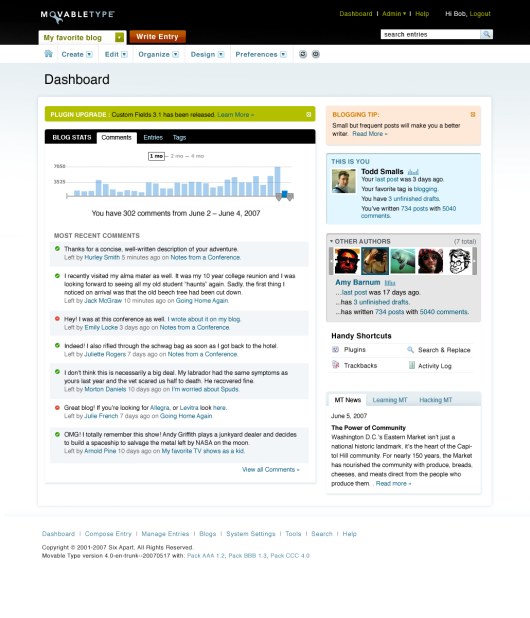MovableType, from SixApart, is one of the oldest blogging platforms on the market but last night the MT team released a new version that’s worth taking note of. It sounds like they are taking a very smart approach; learning from best of breed related apps (many of which they also own) and developing towards where users appear to be headed. (skip to the meat of this post)
 SixApart’s Anil Dash pinged me yesterday and said that the basics are this: MT 4.0 will go open source in Q3 and it will incorporate lessons learned from other SA products – the media handling and templates of Vox, the publishing control of Typepad, the scalability and OpenID support of LiveJournal. That sounds very intriguing to me; I’ll be checking out MT the next time I set up any website and recommend that others look at it as well, in addition to WordPress. I hope it’s easier to install and customize. Let’s be honest, that project logo above doesn’t evoke the kinds of smooth user experience that it ought to. There is a WP to MT importing tool available, that’s good news.
SixApart’s Anil Dash pinged me yesterday and said that the basics are this: MT 4.0 will go open source in Q3 and it will incorporate lessons learned from other SA products – the media handling and templates of Vox, the publishing control of Typepad, the scalability and OpenID support of LiveJournal. That sounds very intriguing to me; I’ll be checking out MT the next time I set up any website and recommend that others look at it as well, in addition to WordPress. I hope it’s easier to install and customize. Let’s be honest, that project logo above doesn’t evoke the kinds of smooth user experience that it ought to. There is a WP to MT importing tool available, that’s good news.
Here’s the press release for the announcement and here ‘s Duncan Riley’s coverage on TechCrunch. Richard MacManus, at the MT powered ReadWrite Web blog, has a typically thoughtful write up as well.
MT says it currently powers sites for organizations ranging from “the Washington Post to the Huffington Post, from General Motors to Nissan Motors, Boeing to BoingBoing, Intel to Instapundit.” None of those are particularly elegant sites, but they aren’t messing around either.
If MT can nail the uptime issue that plagues WP on some high traffic sites then that alone will lead some people to switch.

Will MT remain a financially viable product if liscences are free and its pro level support that’s monetized? Sounds like a very good plan to me. Blogging platforms are essentially commodities now, there are enough of them that no matter how good they are few people will pay much for the software itself anymore. Support, on the other hand, will probably always be the kind of value-added service that can serve a vendor well. It will be interested to see if SixApart is undercut in support pricing for an open sourced MovableType. I’d love to see numbers on how this is same type of enterprise plan is going for WordPress.
We’ll see how the open sourcing goes, there is such a strong open source developer community built up around WordPress that MT will probably take some time to build up a signifigant one themselves. One caveat here is that there’s also a strong community building up around Drupal, which bears some resemblance to MT but is arguably not much fun to use. I won’t claim any expertise regarding the open source community (see my friend Dawn’s take on this from that perspective) but I wouldn’t be surprised if some number of people are excited to get their hands on the code developed by the pros at SixApart for not just MT but also Vox, Typepad and LiveJournal – some of which will now be integrated into MT and thus presumably open sourced as well.
One of the things that the company learned from Typepad is that people like widgets. It’s obvious from WP and Drupal that people also like full-scale plug-ins. MT 4.0 will come with a library of plug-ins and 15 preselected profiles with thematic collections of plug-ins pre-installed. That sounds very smart; we’ll see if it’s truly useful and wether different types of organizations truly want and need different collections of plug-ins.
Two-way OpenID support will now be a part of MovableType. That’s great news. SixApart’s LiveJournal was one of the earliest players in OpenID and for readers and writers of large, MT powered blogs to be able to offer OpenID login for authors and commenters is another big step for this important movement. OpenID support is a real bear to install in WordPress if you’re unfamiliar with working on the command line level – hopefully MT implementation will be much simpler. Ease of installation for semi-technical users in general is a big question I have about this new version, it would be great if SixApart worked with web hosts to offer one-click install like many do of WordPress.
Media handling ala Vox will hopefully be improved upon as its ported into MT – that was the one thing I was a little critical of in the release of Vox. Vox is a great blogging product in terms of privacy, aesthetics and social networking functionality, but its much vaunted media handling feels strange to me. Media items are oddly sequestered on blogs instead of being integrated gracefully. That’s the way it seemed to me last time I looked, at least.
The ability to easily modify the look and feel of the admin dashboard sounds interesting to me and the MT appears to offer much more sophisticated reporting and analytics than other comperable products on the market. It’s also got a reputation for being more complicated and less flexible – we’ll see if that’s still the case.
I will definitely check out the new MovableType when the opportunity and need arise – but I’ll remain cautiously optimistic about this old-school software’s ability to update itself and become as elegant as users today prefer.
 As part of some recent consulting work, I spent some time looking at the new people-search engine from Squidoo called SquidWho (it is not Squidoo I was consulting for). SquidWho is an interesting service that may or may not be worth using (in most cases I think not) but there are a lot of things the team is doing very, very well. It’s worth checking out the site’s user experience and use-flow; it’s all quite well put together.
As part of some recent consulting work, I spent some time looking at the new people-search engine from Squidoo called SquidWho (it is not Squidoo I was consulting for). SquidWho is an interesting service that may or may not be worth using (in most cases I think not) but there are a lot of things the team is doing very, very well. It’s worth checking out the site’s user experience and use-flow; it’s all quite well put together. 

 The second cool thing about Technorati is the company’s partnerships with outside traditional large publishers. Specifically, the kinds of relationships they’ve built
The second cool thing about Technorati is the company’s partnerships with outside traditional large publishers. Specifically, the kinds of relationships they’ve built  SixApart’s Anil Dash pinged me yesterday and said that the basics are this: MT 4.0 will go open source in Q3 and it will incorporate lessons learned from other SA products – the media handling and templates of Vox, the publishing control of Typepad, the scalability and OpenID support of LiveJournal. That sounds very intriguing to me; I’ll be checking out MT the next time I set up any website and recommend that others look at it as well, in addition to WordPress. I hope it’s easier to install and customize. Let’s be honest, that project logo above doesn’t evoke the kinds of smooth user experience that it ought to. There is a WP to MT importing tool available, that’s good news.
SixApart’s Anil Dash pinged me yesterday and said that the basics are this: MT 4.0 will go open source in Q3 and it will incorporate lessons learned from other SA products – the media handling and templates of Vox, the publishing control of Typepad, the scalability and OpenID support of LiveJournal. That sounds very intriguing to me; I’ll be checking out MT the next time I set up any website and recommend that others look at it as well, in addition to WordPress. I hope it’s easier to install and customize. Let’s be honest, that project logo above doesn’t evoke the kinds of smooth user experience that it ought to. There is a WP to MT importing tool available, that’s good news.
